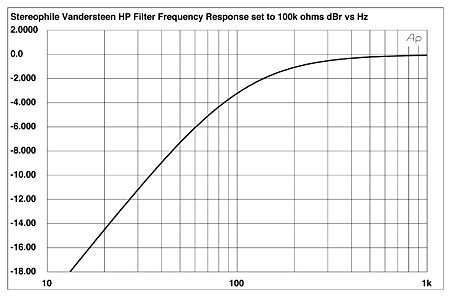For those not familiar with the Vandersteen M5-HPB highpass filter, it's used with the Quatro and other speakers in the line to keep low frequencies out of the mid-bass driver by attenuating frequencies at 6 dB per octave (first order filter), with a -3 dB point at 100 Hz. These are small boxes that are meant to be hooked up between your pre-amp and amp.
You can see a pic of the guts of one here:
http://www.head-fi.org/t/162792/inside-look-a-high-end-balanced-crossoverAnd here is John Atkinson's measurement of the response of the filter from Stereophile:

The main takeaway from the graph is that the filter response should be down about 14 dB at 20 Hz.
Unfortunately the accuracy of the Vandersteen highpass filter with my Rogue M-180 tube monoblocks is disappointing.
Here are some measurements I did with my HP400E AC voltmeter. All measurements are from the 8 Ohm taps of my Rogue M-180 amps.
In the table below, "ideal" is the ideal frequency response for a 1st order highpass filter with -3dB@100Hz knee* (see bottom of page). The Stereophile graph also shows the response of the filter with an "ideal" load.
"100kOhm" indicates measurements with the 100 kOhm setting on the highpass dipswitches (all dip switches off). This was the setting that was closest I could find to having the -3dB knee at 100 Hz.
"diff" is the difference between ideal and measured.
Note the large dropoff at the bottom of the range.
freq "ideal" 100kOhm diff
===========================
100 -3.0 -2.2 0.8
90 -3.5 -2.6 0.9
80 -4.1 -3.3 0.8
70 -4.8 -4.0 0.8
60 -5.8 -5.2 0.6
50 -7.0 -6.8 0.2
40 -8.6 -9.0 -0.4
30 -10.8 -12.4 -1.6
20 -14.1 -18.4 -4.3
So not only is the -3 dB "knee" in the wrong place, the slope seems to be too steep at the bottom end. But this is the closest I can find to -3 dB @ 100 Hz with the documented settings for the highpass filter. (Rogue's specified input impedance on their website of 200 kOhm seems to be way off.)
Here's an undocumented dipswitch setting I found, switches 4, 5, and 10 on. Better -3 dB point, but still a steeper slope than ideal.
freq 4,5,10 diff
==================
100 -3.2 -0.2
90 -3.8 -0.3
80 -4.5 -0.4
70 -5.2 -0.4
60 -6.4 -0.6
50 -7.8 -0.8
40 -10.0 -1.4
30 -12.5 -1.7
20 -17.0 -2.9
I have some Rothwell XLR inline 10 dB attenutors, so I placed them between the highpass filter and the amps. With the attenuators between M5-HPB and the amps the setting closest to -3dB@100Hz was 20kOhm (switches 1, 8, and 10). So the attenuators effectively lower the input impedance of the amps. Here the "RW" column is the measurements with the attenuators in place.
freq RW diff
===============
100 -2.5 .5
90 -3 .5
80 -3.5 .6
70 -4.2 .6
60 -5 .8
50 -6.3 .7
40 -8 .6
30 -10.5 .3
20 -14 .1
Now this is pretty good. The slope is much closer to ideal, and the differences are fairly constant so can mostly be "adjusted away" with the bass level on the speaker.
I'm not sure I like the "sound" of the Rothwell attenuators, so I'd be interested in hearing about other ways to modify the effective input impedance of the amp to get a better filter response.
For reference, here's a measurement with a Bryston 3B-SST (balanced connection; 2V sensitivity; no attenuation.) Again the 20 kOhm setting is used since the Bryston has a 10 kOhm input impedance per balanced leg.
freq 3BSST diff
================
100 -3.3 -.3
90 -3.8 -.3
80 -4.5 -.3
70 -5.2 -.4
60 -6.2 -.4
50 -7.5 -.5
40 -9 -.4
30 -11.2 -.4
20 -14.7 -.6
(The Rogue's stomp all over the Bryston for sound quality, by the way, accurate highpass filtering or not.)
* According to the sox audio program, the "transfer function", H(f), for a 1st order highpass filter with -3dB@100 Hz knee is
Fs=44100
b0=9.929267154013539e-01; b1=-9.929267154013539e-01; b2=0.000000000000000e+00; a1=-9.858534308027079e-01; a2=0.000000000000000e+00
o=2*pi/Fs
H(f)=sqrt((b0*b0+b1*b1+b2*b2+2.*(b0*b1+b1*b2)*cos(f*o)+2.*(b0*b2)*cos(2.*f*o))/(1.+a1*a1+a2*a2+2.*(a1+a1*a2)*cos(f*o)+2.*a2*cos(2.*f*o)))
The response in dB would be 20*log10(H(f)), where f is frequency in Hz.